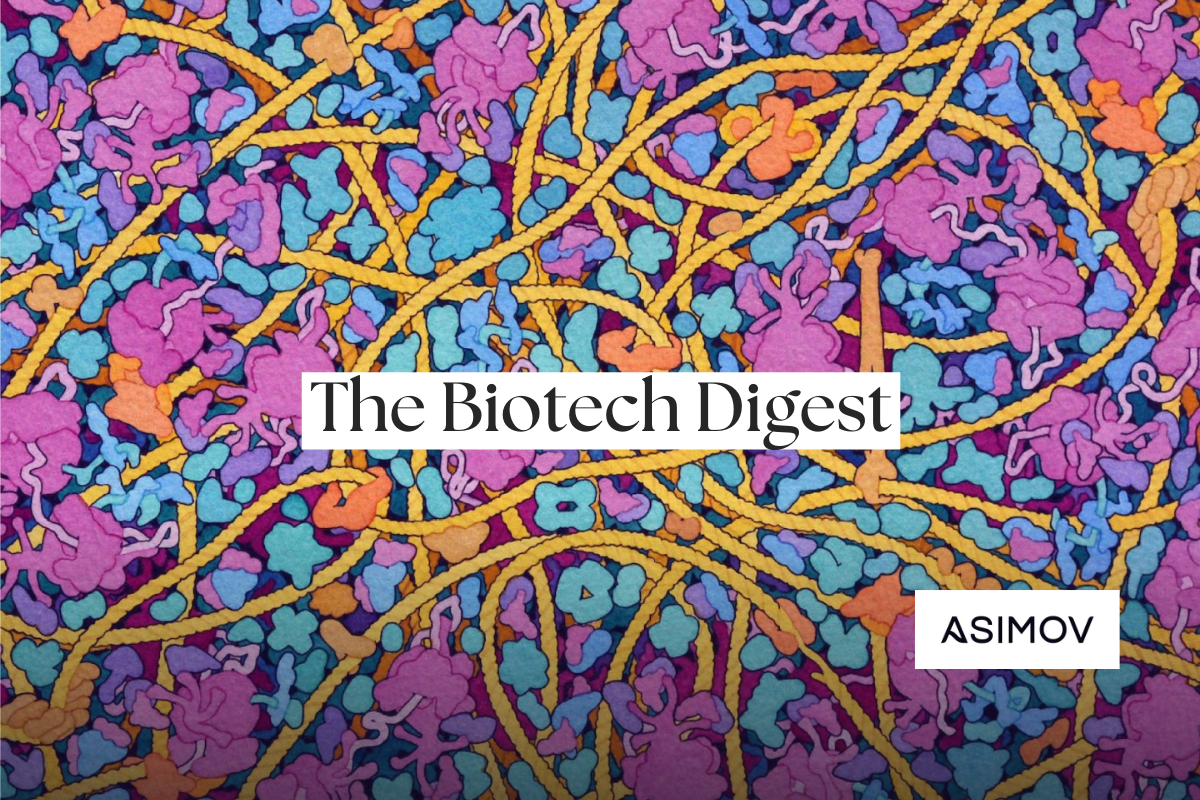The Biotech Digest No. 1
By Niko McCarty
We’re launching a weekly digest to highlight recent papers and news in biotechnology. This is the first edition. Please send feedback to niko@asimov.com.
Gene Therapy for Cystic Fibrosis (in Mice)
Cystic fibrosis is caused by a mutation in a single gene that messes up a protein (called cystic fibrosis transmembrane conductance regulator, or CFTR) that, in turn, causes mucus to build up in the lungs. It’s a terrible disease, and one of the drugs used to treat it—called Trikafta, approved in 2019—costs something like $300,000 per year. Trikafta is used to treat people with the most common mutation in the CFTR gene, called F508del. But of course, patients need to take this expensive medicine every day, or else the benefits go away.
A gene therapy for cystic fibrosis would, therefore, be a big deal. For a study in Science this week, researchers packaged mRNA encoding a base editor and guideRNA targeting the CFTR gene into lipid nanoparticles, and then injected them into mice. The guideRNA was designed to target a different—but still common—mutation that causes cystic fibrosis, called R553X, in which a stop codon is erroneously inserted into the CFTR gene. In the study, the base editor binds to this gene, swaps out a misplaced adenine, and replaces it with a guanine to restore the correct amino acid and allow the CFTR protein to be made in full.
In human cell culture experiments, the guideRNA and base editor restored CFTR activity to 53% of its normal levels, which exceeds the 10% threshold that is thought to be needed to prevent symptoms. When this experiment was repeated in mice, a single injection corrected the R553X mutation in 50% of lung stem cells, 12.2% of total lung cells, and 28.7% of tracheal cells after 10 days. The next step, of course, will be to test this gene therapy in more cystic fibrosis animal models, especially pigs and ferrets, to see how they fare.
Self-Healing Peptide Glass
Glass was invented some 4,000 years ago by craftsmen in Mesopotamia, who heated open molds filled with sand, soda and lime to form pendants and small shards for jewelry. Glassmaking has obviously improved in the millennia since, but the final products are much the same—glass still shatters, cracks, and breaks.
A paper this week in Nature reports a glass, made from tiny peptides (specifically, three tyrosines connected together), that can self-heal at room temperature. The glass is strong; it crosslinks with water and forms non-covalent bonds that hold everything in place. A small drop of this stuff has a refractive index of 1.52, so looking through it is a bit like looking through an optical lens.
The researchers put the glass through a few different tests. First, they used it to adhere two microscope slides together and then attached them to a five kilogram load; everything held up. In another experiment, they placed the glass in a room without moisture. Cracks formed, but then rehealed within 20 seconds after moisture was added back in.
Large DNA Insertions
The holy grail of gene-editing is, basically, to “put any sequence of DNA of any size in any location in the genome, with complete control.” That quote comes straight from John Finn, CSO of Tome Biosciences, a Harvard spin-out trying to do exactly that.
Unfortunately, most gene therapies today target specific mutations, and therefore can’t address a wide array of genetic diseases. Cystic fibrosis, for example, has been linked to 2,000+ different mutations; a therapy approved to treat one of them can't necessarily be used to treat the others. The dream scenario, then, is to build technologies that can swap out faulty genes entirely and replace them with a healthy version, in exactly the correct location (and without messing up other stuff in the genome). Recently, things have been heating up in this space.
For a Nature Biomedical Engineering paper out this week, David Liu’s group at Harvard released an improved method for integrating large DNA sequences into precise locations in mammalian genomes. It’s an expansion of prior work from the same group, but this paper is important because they evolved an enzyme—called Bxb1, a recombinase that swaps DNA chunks into locations in the genome that carry a specific recognition site—that are much better at doing this than anything published before.
The evolved Bxb1 proteins were tested at 12 different genomic sites in human and mouse cells. One of the protein variants, eeBxb1, could insert gene-sized DNA sequences with efficiencies up to 46%, a 4.2-fold average improvement over the group’s prior work. In primary human fibroblasts, a more challenging cell type to edit, eeBxb1-PASSIGE attained up to 30% integration efficiency at genes linked to diseases. These integration efficiencies are among the highest reported so far for large DNA sequences in mammalian cells, and the method worked for genes stretching up to 10.5 kilobases.
Note that PASSIGE is similar to the method that Tome uses, called PASTE, which was first reported in a 2021 bioRxiv preprint. John Finn wrote an interesting response to this recent Liu paper, called “Distinctions without a Difference,” which is also worth reading.

Papers You Might Have Missed
- AAVs engineered to slip through the blood-brain barrier after it opens via focused ultrasound. Nature Communications
- Loads of papers on the impacts of spaceflight on human physiology (courtesy of the SpaceX Inspiration4 crew) came out in various journals. See astronaut -omics, neuronal effects, radiation, molecular changes, and telomeric RNA.
- A single-molecule, long-read sequencing method. Nature
- An atlas of microbe/human protein interactions. Cell
- Assessing the pandemic potential of H1N2. Nature Communications
- Reliable method to make retinal organoids from pluripotent stem cells. PNAS
- Ancient genome sequences explain malaria’s spread. Nature
- Deep learning predicts protein translation rates from 5’ UTR sequences. Nucleic Acids Research
- Computational tool to design barcode libraries. Nature Computational Science
- Plasmid segregation in an artificial cell. Nature Communications
- Mining extinct organisms to find antibiotics. Nature Biomedical Engineering
- Discovery of 89 genes involved in bioleaching (getting metals out of ores). bioRxiv
- LacI engineered to respond to light instead of IPTG. Nucleic Acids Research
- Artificial cells with separate droplets for transcription and translation. bioRxiv
- Circulating RNA in the blood can be used to diagnose tuberculosis. Nature Communications
- Treating liver disease (in mice) using mRNA packed into lipid nanoparticles. Nature Communication
- (Another) pig to macaque kidney transplant study. Science Translational Medicine
- Discovery of more enzymes to degrade PET plastic and its derivatives. Communications Biology
- A Down syndrome in vitro model. Science Advances
- A faster way to do cryo-EM. Communications Biology
- A new, stable DNA structure forms when synthetic ‘Z’ nucleotides are added. Nature Chemistry
- Discovery of 51 peptides that activate gene expression in plants. Cell Systems
- A new way to fix sickle cell disease in vitro. Nature Communications
- Machine learning to calculate optimal gene copy numbers. Nature Chemical Biology
- A computational tool to design gRNAs with predictable effects on gene expression. bioRxiv
- A radiotherapy for melanoma, using liposomes and aptamers. Nature Communications
In Other News…
- A CASP competition, but for protein engineering. Results are in! Align to Innovate
- Thousands of papers misidentify genes and list cell lines that don’t actually exist. In the Pipeline
- Pioneer Labs launches “to engineer microbes for Mars.” Pioneer Labs
- Do plants have minds? Aeon
- Prolific Machines, a company that makes bioreactors and genetic tools to control cells with light, raises a $55 million series B. Tech Crunch
- Flagship Pioneering partners with ProFound Therapeutics to search for obesity drug candidates; Pfizer will have options to license or acquire. Biopharma Dive
- There’s no biological reason we can’t get to Mars and back. The Washington Post
- mRNA vaccines for cancer, and how they work. Nature


